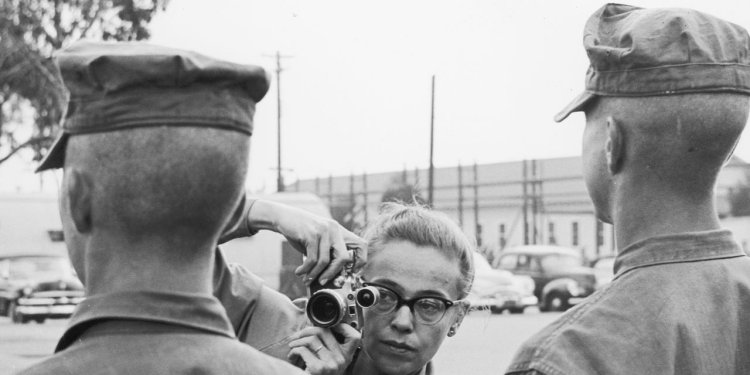‘First to the Front’ Review: A Leading Lady of Journalism
One editor tagged her the ‘bayonet border correspondent’ since she was usually among the first to arrive at a combat zone. Dickey Chapelle photographs Marines in 1955. Photo: Wisconsin Historical Society By Charlotte Gray Aug. 7, 2023 5:58 pm ET The life of Dickey Chapelle reads like a Hollywood movie. A pearl-earringed photojournalist and war correspondent confounds all stereotypes, breaking stories and outdoing the U.S. Marines in bravery; she is honored by freedom fighters, consulted by Pentagon brass and rewarded with the Presidential Medal of Freedom before retiring to an emeritus professorship. This all happened to the real Dickey Chapelle—born Georgette Meyer in Milwaukee in 1918—except for the Medal of Freedom and the professorship. Instead, Chapelle was killed in 1965 while on a patrol with a Marine platoon in


Dickey Chapelle photographs Marines in 1955.
Photo: Wisconsin Historical Society
The life of Dickey Chapelle reads like a Hollywood movie. A pearl-earringed photojournalist and war correspondent confounds all stereotypes, breaking stories and outdoing the U.S. Marines in bravery; she is honored by freedom fighters, consulted by Pentagon brass and rewarded with the Presidential Medal of Freedom before retiring to an emeritus professorship.
This all happened to the real Dickey Chapelle—born Georgette Meyer in Milwaukee in 1918—except for the Medal of Freedom and the professorship. Instead, Chapelle was killed in 1965 while on a patrol with a Marine platoon in Vietnam and was soon forgotten. Many of her reports and dispatches never made it to press, either because she couldn’t find a news outlet for them or because censorship stifled them. She was patriotic, principled and tough to the point of recklessness. As Lorissa Rinehart describes in “First to the Front,” Chapelle insisted on seeing every story with her own eyes, describing events from the point of view of the grunts rather than the generals. “By every right,” Ms. Rinehart writes, “Dickey Chapelle should be a household name.”
Obsessed since childhood by the thrill of flight, Chapelle was one of three women accepted into MIT’s aeronautical-engineering class in 1934. She was bright, but more than that, she was intrepid. After flunking out of school (she preferred watching planes to designing them), she worked at a local air circus so she could take flying lessons. She soon realized that there was a market for articles about air shows, and after the New York Times ran one of her stories, the publicity chief of Howard Hughes’s Transcontinental & Western Air (later TWA) offered her a job as his assistant.
When war broke out in Europe in 1939, she “saw the world teetering on the precipice of a historical moment,” Ms. Rinehart tells us, “and knew she had to be a part of it.” Her ambition was to be a photojournalist, so she signed up for classes with TWA’s publicity photographer. Anthony Chapelle was twice her age, charismatic, gregarious and a good teacher, and Dickey fell in love with him. The two married in 1940.
Dickey Chapelle’s first chance to report on military maneuvers came in 1942, when Look magazine sent her to photograph the 14th Infantry Regiment training in the Panamanian jungle. She proved herself to be as tenacious and courageous as the trainees, shouldering her own heavy camera equipment through the stifling humidity and clouds of mosquitoes. But military censors back home blocked her photos from appearing in print, on the grounds that the images posed a threat to national security.
Her next chance at the front came in 1945, when she received a commission and official accreditation to travel to the Pacific theater. Up until then, no female photographer had been given access to combat zones; she began by attaching herself to the Navy’s nursing corps, responsible for evacuating casualties to U.S. hospitals. She soon elbowed her way to Pearl Harbor, and then to Iwo Jima, where she covered the Marines in battle. As she photographed the wounded being loaded onto a hospital ship and trained her lens on the young men bleeding to death, she honed the skill and steely detachment she needed to weave their stories together into a gripping narrative.
By now, Chapelle was completely bitten by the war-reporting bug. Her coverage focused on the soldiers, sailors, nurses, airmen, guerrillas and refugees whose lives had been seared by war. Part of her mission, she told her military escorts, was to convey the importance of blood donations back home. This immediately endeared her to everyone, “from the shiniest brass button to the dirtiest grunt boot,” as Ms. Rinehart puts it. However, her success in capturing the action, despite orders to stay on the hospital ship, resulted in her press credentials being rescinded. Few of her pieces were published.
After the war, she persuaded the Quakers to send her on an extended trip to Eastern Europe to photograph families, and particularly children, traumatized by war and its outcomes—starvation, homelessness, sickness. Within years, prestigious publications such as National Geographic were using her photos and stories. In 1956, while covering the Hungarian Revolution, she was captured and jailed for six weeks, including five in solitary confinement. The experience left her psychologically wounded and turned her hostility toward totalitarian regimes into a fierce determination, Ms. Rinehart writes, “to beat back the tide of communism” and tell “the stories of others fighting for their freedom.”
Chapelle’s mission would lead her to embed herself with the Algerian rebels in their fight against French rule, and with Fidel Castro’s
guerrilla army in the Cuban Revolution. One editor tagged her the “bayonet border correspondent” since she was usually among the first at the front. By 1961, she was reporting on the American forces’ efforts to repel the Viet Cong. By the time of her death in 1965, she had grown exasperated by what she saw as the inability of U.S. military leaders to understand guerilla warfare, and the CIA’s complicity in the illegal expansion of the war. But military censorship prevented her from reporting about her outrage. “Perhaps Dickey should have known she was about to walk into one of the darkest periods of American history,” Ms. Rinehart writes. But she could not turn back, due to “her own naivete or fear or desire to believe that America could still be a beacon for freedom.”“First to the Front” tells an extraordinary story with a great sense of drama and lots of gruesome details. It is hard to tell where many of those details came from because there are no footnotes. Instead, the author lists the primary sources for each chapter, almost all of which are Chapelle’s own notes, letters, articles and her autobiography (originally titled “What’s a Woman Doing Here?”). So the story is told almost exclusively from Chapelle’s point of view, with (presumably) flourishes of color by the author but without comment from Chapelle’s editors, peers or contacts—who no doubt admired her work but may have been irritated by her appetite for risk and her missionary zeal. To those who were the focus of her coverage, however, Dickey Chapelle was always a hero. At her Milwaukee funeral, the first for an American female journalist to be killed in combat, a Marine honor guard attended in full dress.
Ms. Gray is the author of “Passionate Mothers, Powerful Sons: The Lives of Jennie Jerome Churchill and Sara Delano Roosevelt,” which will be published in September.
What's Your Reaction?













